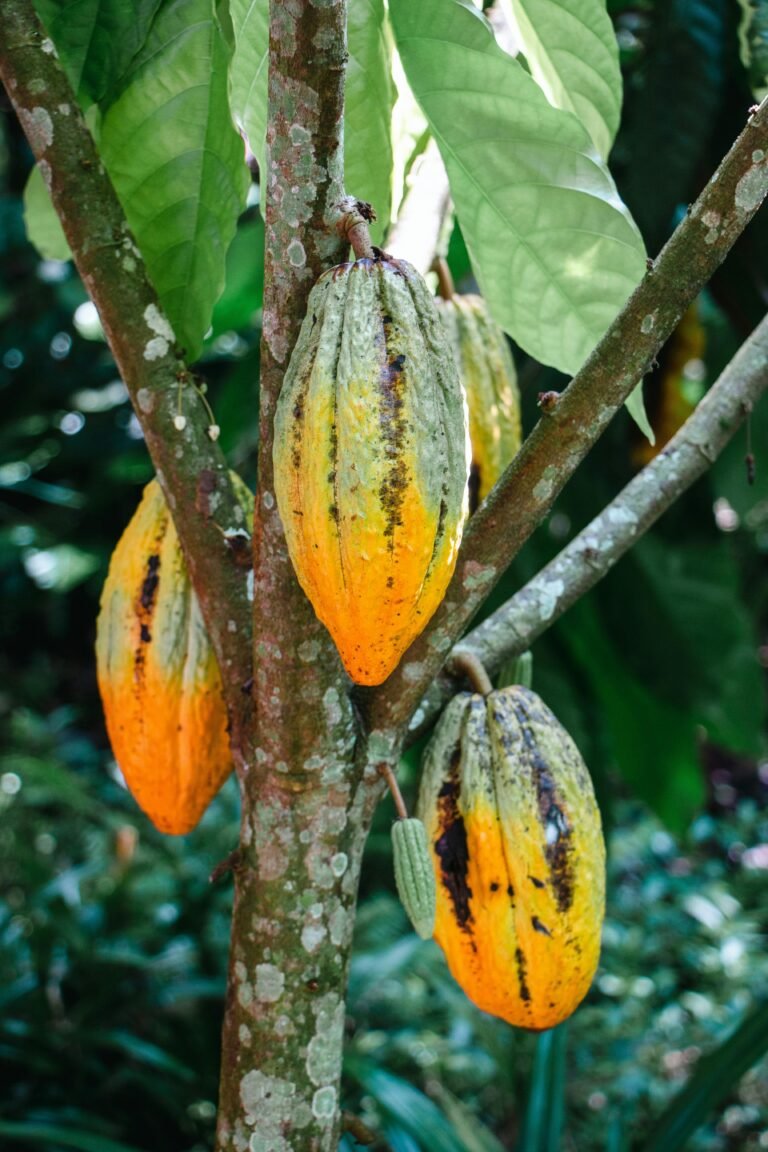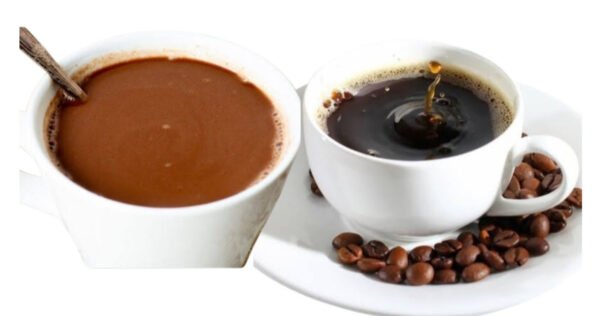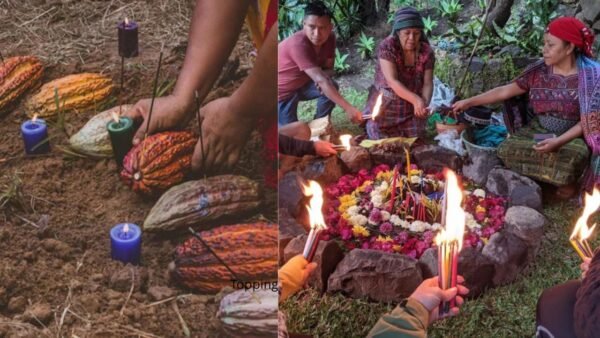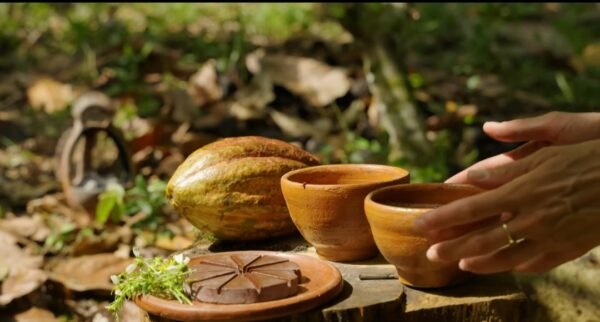
Ceremonial cacao is a pure, unprocessed or minimally processed form of cacao, traditionally used in healing and spiritual rituals. It’s made from whole, fermented cacao beans—either raw or lightly roasted—preserving natural fats and nutrients.
Ceremonial cacao is popular in spiritual communities. I first discovered ceremonial cacao in Rishikesh, India. There, spiritual communities often conduct cacao ceremonies where people gather together and consume ceremonial cacao as a part of the ritual. They use it for healing, heart-opening, and deeper connection.
Origin of ceremonial cacao
Ceremonial cacao started thousands of years ago with the Olmecs, Maya, and Aztecs civilizations in Central and South America. They honoured the cacao. For them, cacao was a sacred gift from the divine.
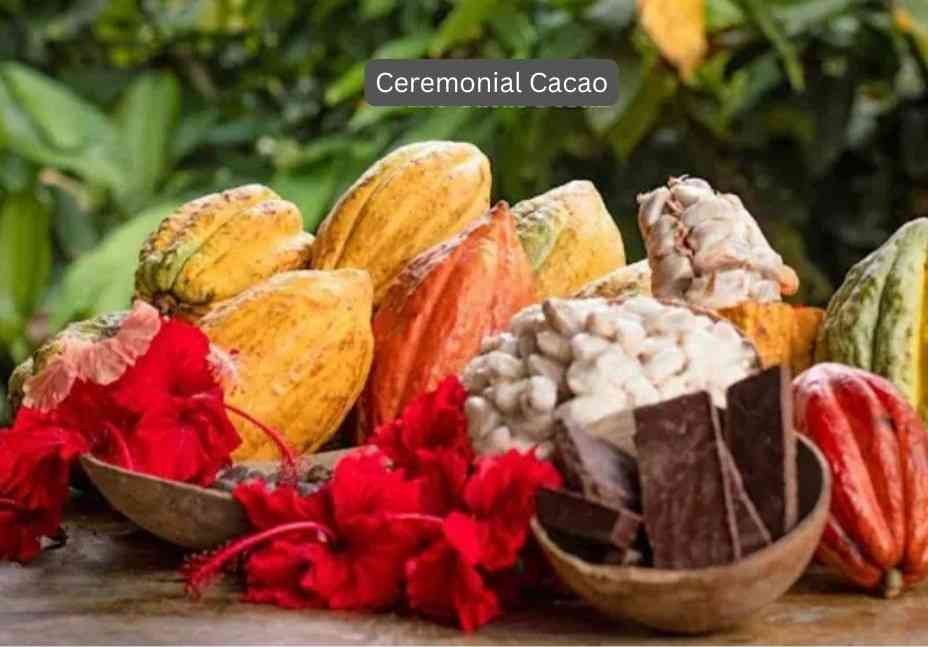
Uses of Ceremonial Cacao
Ancient Uses of Ceremonial Cacao:
Ancient Maya and Aztecs – They used ceremonial cacao in sacred rituals such as spiritual communion, birth, weddings, funerals, fertility, medicine, and even as currency. They also used it in battle. Before battle, warriors drank ceremonial cacao for strength.
In Modern-Day Use of Ceremonial Cacao:
In modern times, people use ceremonial cacao for healing, heart opening, clarity, connecting with the divine energy or spiritual awakening. In modern days, people use ceremonial cacao in various places such as yoga centres, retreats, meditation centres, etc.
The process of making ceremonial cacao
Ceremonial cacao is prepared with intention and reverence.
To make ceremonial cacao, they select high-quality cacao pods grown with intention, using organic, eco-friendly, and sustainable methods.

First, they hand‑pick fully ripe cacao pods directly from the field using precise cuts, ensuring only the best are selected for ceremonial cacao.
After harvesting ripe cacao pods, they split the pod and take out the beans along with the pulp. Without separating the pulp from the beans, they let them ferment. The beans are fermented—usually 2–6 days—to develop their rich flavours and reduce bitterness.
Once the fermentation is complete, they let the beans air-dry under the sun. After drying, the cacao beans are lightly roasted at very low temperature so that the beans retain their natural components and nutritional value. Once the cacao beans are roasted, their shells are removed. Then the roasted beans are stone-ground into a smooth cacao paste.
Finally, this paste is gently dissolved into hot water to make the ceremonial cacao drink – sometimes referred to as ‘cacao liquor’.
To prepare ceremonial cacao, every process must be done with good intention, honour and respect.
How to Drink Ceremonial Cacao
Choose a quiet and comfortable place. Pour the warm ceremonial cacao into a cup. Gently hold the cup close to your heart. Now, close your eyes and take some slow and deep breaths. Set your intention or think about what you wish to invite into your life – whether it’s healing, clarity, connection, or something personal. Speak your intention aloud, or if you don’t want to speak it out loud, then it’s ok; just hold it in your mind silently.
Now, slowly open your eyes and take a gentle sip of your ceremonial cacao drink. Feel the rich taste, the warmth on your lips, and the way it spreads through your body.

When you finish, close the ritual by expressing gratitude—for the cacao, the moment, and yourself.
What is the Difference Between Regular Cacao and Ceremonial cacao?
| Ceremonial Cacao | Regular Cacao |
| Bean Quality & Origin: Made from heirloom varieties (Criollo or Trinitario), often single-origin, ethically sourced from small farms. | Bean Quality & Origin: Usually from mixed or disease-resistant beans (e.g., Forastero), sourced via commercial supply chains. |
| Hand-harvested, fermented in banana leaves or wooden boxes for 2–7 days, sun-dried, lightly roasted, stone-ground into paste—no additives | Machine-harvested, heavily roasted at high temperatures, alkalized (“Dutch-process”), hydraulic pressing to remove butter, often defatted and sweetened. |
| Unprocessed or sometimes minimal processed | Heavily processed |
| Sold as pure cacao paste, blocks, or discs. (often called cacao liquor) | Mostly available as powder or mass—often defatted and sometimes alkalized. |
| Cacao butter intact. | Cacao butter removed. |
| Earthy, slightly bitter, complex flavor; creamy texture due to preserved cacao butter. | Milder, sweeter; often lacks depth—powder form is chalky or dry. |
| High in antioxidants, flavonoids, minerals (magnesium, iron), theobromine, anandamide; natural fats aid nutrient absorption. | Lower nutrient density due to high-heat processing and fat removal; may include added sugar, reducing health benefits. |
| Used in heart-opening ceremonies, meditation, spiritual rituals, mindful drinking. | Primarily for baking, snacking, confectionery -focused on taste and convenience. No spiritual context |
| Sourced with intention from small farms, sustainable and respectful practices honouring historical traditions. | Often industrial, large-scale farming; little focus on spiritual or mindful practices. |
Ceremonial cacao is pure, unprocessed or minimally processed. Ceremonial cacao is cultivated in a sustainable, eco-friendly and traditional way. There are no additives, no sugar, no preservatives, or any artificial sweetener used in the ceremonial cacao. Ceremonial cacao is completely pure and natural. The purpose of ceremonial cacao is spiritual connection, heart opening, divine communication, prayer, meditation and mindfulness, healing, spiritual awakening, presence that reconnects us to ancient traditions, etc.
On the other hand, the regular cacao is highly processed and may include various additives, sugar, etc. Regular cacao comes in powder form. The regular cacao is primarily used for developing flavour in food products—less about wellness or ritual.
Final Thought
I hope you are now clear about what is ceremonial cacao? and how does it differ from regular cacao, right?
Ceremonial cacao is not just a drink—it’s a ritual passing through generations, now nourishing modern seekers. With each sip, it opens the heart, calms the mind, and connects us spiritually – just as it did for ancient Maya and Aztec ceremonies.
Thank you for showing your interest in knowing about ceremonial cacao! Do share your thoughts in the comment box below.
You may also like to read

